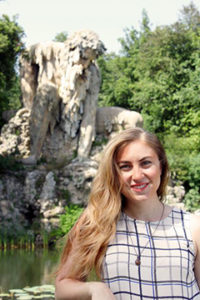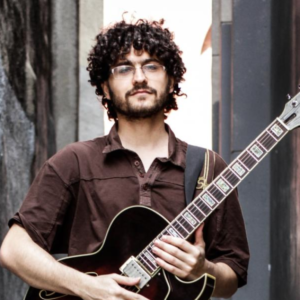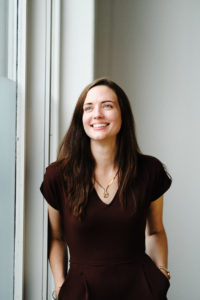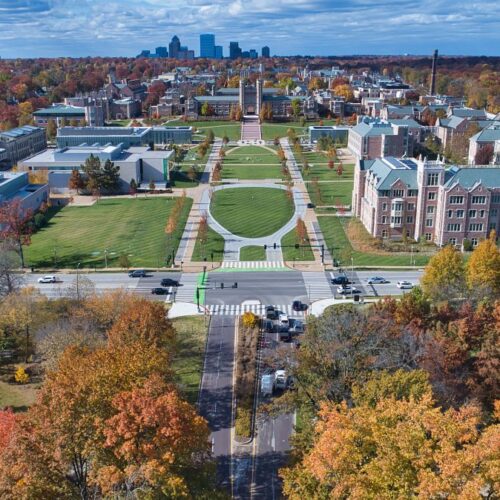
WashU Grad Students Attend National Humanities Center Virtual Residency
From July 11-15th 2022, the CTL proudly sponsored four graduate students in humanities departments at WashU to attend the National Humanities Center’s Meaningful Teaching and Learning in the Humanities Classroom. During the week, WashU grad students engaged in team-based learning with graduate students from peer institutions to create instructional materials and to learn from a wide range of faculty and pedagogy-specialists from across the United States. We asked our WashU students to share their reflections on the program. You can find excerpts from their reflections below.
Emily Thompson, Art History and Archaeology
 “My week with the National Humanities Center Residency program was truly inspiring and revitalizing. The group of faculty and graduate students that participated built an environment where we were free to explore new ideas and work through our teaching concerns. As such, a main takeaway from the week was that it is okay to try new policies and strategies in the classroom and fail—not just fail, but fail gracefully and humbly. We can create a learning community in our classrooms from day one and we can earn the respect and latitude from our students to experiment with new methodologies all while keeping them involved and engaged. However, I think the concept that made the most immediate impact on me is to “not let your syllabus be a graveyard of past student transgressions.” Each new group of students has a unique perspective and deserve instructors who willingly adapt each time they step into a new classroom. Of the many concepts I learned, I have already implemented this guidance into my class this summer and I look forward to sharing this advice with others. Not only did we walk away with new ideas for the classroom, but we also gained experience building an interdisciplinary syllabus with our small groups; the final syllabus is now something I can build on in the future. Working with scholars and graduate students from a variety of fields and circumstances was an eye-opening and educational experience—I am eager to continue this kind of intercollegiate teaching community during my remaining time at WashU. While there were several new pedagogy concepts that we discussed during the program, the one that I will continue to think about is Ungrading. This is a brand-new concept for me that was discussed a lot during the residency programming, and I am eager to see how I can integrate this practice into my classroom in the future!”
“My week with the National Humanities Center Residency program was truly inspiring and revitalizing. The group of faculty and graduate students that participated built an environment where we were free to explore new ideas and work through our teaching concerns. As such, a main takeaway from the week was that it is okay to try new policies and strategies in the classroom and fail—not just fail, but fail gracefully and humbly. We can create a learning community in our classrooms from day one and we can earn the respect and latitude from our students to experiment with new methodologies all while keeping them involved and engaged. However, I think the concept that made the most immediate impact on me is to “not let your syllabus be a graveyard of past student transgressions.” Each new group of students has a unique perspective and deserve instructors who willingly adapt each time they step into a new classroom. Of the many concepts I learned, I have already implemented this guidance into my class this summer and I look forward to sharing this advice with others. Not only did we walk away with new ideas for the classroom, but we also gained experience building an interdisciplinary syllabus with our small groups; the final syllabus is now something I can build on in the future. Working with scholars and graduate students from a variety of fields and circumstances was an eye-opening and educational experience—I am eager to continue this kind of intercollegiate teaching community during my remaining time at WashU. While there were several new pedagogy concepts that we discussed during the program, the one that I will continue to think about is Ungrading. This is a brand-new concept for me that was discussed a lot during the residency programming, and I am eager to see how I can integrate this practice into my classroom in the future!”
Juan Manuel Ramírez Velázquez, Romance Languages and Literatures (Hispanic Studies)
 “During the 2022 one-week summer residency on teaching with the National Humanities Center, I had the opportunity to learn about inclusive practices in the classroom from different scholars in the humanities. The practices we learned range from organizing collaborative student projects and assessments to working with international students and incorporating visuals into notetaking and classroom structure. All the information provided within the five-days residency was put into a hands-on activity in our program’s final project. For this assignment, we had to create an interdisciplinary syllabus in groups of three, incorporating different points and principles from the program such as the Universal Design for Learning (UDL) framework. Additionally, through this program, I was able to connect with peers from different universities, learn about their projects, and collaborate on best teaching practices. The residency itself, by bringing together scholars and graduate students with different backgrounds from different programs across the country, was a clear example of inclusive teaching because we actively listened and learned from each other in a respectful manner; each one of us was able to share ideas and experience productive feedback. As an educator, I strive to ensure the reconfiguration of academic pedagogy so that all students may be and feel included in the learning process. In this sense, making classes more accessible and prompting students to participate in meaningful ways are two of the many takeaways from the program that I would like to continue developing for my own pedagogical philosophy and practice.”
“During the 2022 one-week summer residency on teaching with the National Humanities Center, I had the opportunity to learn about inclusive practices in the classroom from different scholars in the humanities. The practices we learned range from organizing collaborative student projects and assessments to working with international students and incorporating visuals into notetaking and classroom structure. All the information provided within the five-days residency was put into a hands-on activity in our program’s final project. For this assignment, we had to create an interdisciplinary syllabus in groups of three, incorporating different points and principles from the program such as the Universal Design for Learning (UDL) framework. Additionally, through this program, I was able to connect with peers from different universities, learn about their projects, and collaborate on best teaching practices. The residency itself, by bringing together scholars and graduate students with different backgrounds from different programs across the country, was a clear example of inclusive teaching because we actively listened and learned from each other in a respectful manner; each one of us was able to share ideas and experience productive feedback. As an educator, I strive to ensure the reconfiguration of academic pedagogy so that all students may be and feel included in the learning process. In this sense, making classes more accessible and prompting students to participate in meaningful ways are two of the many takeaways from the program that I would like to continue developing for my own pedagogical philosophy and practice.”
Felipe Guz Tinoco, Department of Music
 “The 2022 National Center for the Humanities Residency showed me ways to channel my eagerness for social change through teaching. At the opening ceremony, squares with participant’s faces filled my screen while the program coordinator Andy Mink announced that the NHC was a “place of intellectual freedom” and that an engaged instructor is someone who fosters an engaged space…The workshop “Consider the Classroom,” led by Dr. Casender Smith, was particularly relevant to me for how it focused on the ways in which education can be a form of public engagement. In order to actively interact and engage with the students, Dr. Smith argued we must consider who we are as instructors in front of the class. Knowing our positionality and how others see us is key to assessing how we can have an effective dialogue with the public. Dr. Smith asked the participants several questions such as “What are our biases? How do we understand and define diversity? How do we understand and define equality or equity?” Her point, ultimately, was that these questions do not have a single answer for we are different people with different backgrounds and understandings of public engagement. More importantly, these questions should often be re-considered and re-examined for each class and in each classroom, as students and instructors change throughout the semester and beyond. The intense week-long residency left me energized to teach and to consider how I can best effect change in the classroom. I will take these lessons with me in my next semesters at WashU and hope to continue to expand on them.”
“The 2022 National Center for the Humanities Residency showed me ways to channel my eagerness for social change through teaching. At the opening ceremony, squares with participant’s faces filled my screen while the program coordinator Andy Mink announced that the NHC was a “place of intellectual freedom” and that an engaged instructor is someone who fosters an engaged space…The workshop “Consider the Classroom,” led by Dr. Casender Smith, was particularly relevant to me for how it focused on the ways in which education can be a form of public engagement. In order to actively interact and engage with the students, Dr. Smith argued we must consider who we are as instructors in front of the class. Knowing our positionality and how others see us is key to assessing how we can have an effective dialogue with the public. Dr. Smith asked the participants several questions such as “What are our biases? How do we understand and define diversity? How do we understand and define equality or equity?” Her point, ultimately, was that these questions do not have a single answer for we are different people with different backgrounds and understandings of public engagement. More importantly, these questions should often be re-considered and re-examined for each class and in each classroom, as students and instructors change throughout the semester and beyond. The intense week-long residency left me energized to teach and to consider how I can best effect change in the classroom. I will take these lessons with me in my next semesters at WashU and hope to continue to expand on them.”
Laura Evers, Department of English
 “The Meaningful Teaching and Learning in the Humanities residency reminded me why teachers should build into their course design a continuous feedback loop with students. Actively listening to students and incorporating their needs into every facet of class, from the organization of the syllabus to the final course assignment, are hallmarks of a flexible and adaptable teacher who puts student learning first. The speakers at the residency all touched upon how if a teacher wants to create an accessible classroom environment, they should offer multiple ways for students to both learn the content and demonstrate their mastery of the material. There is no “one size fits all” in the learning process and so it is vital to meet students where they are. For example, students who raise their hands to speak are participating in the traditional sense, but for the less talkative students, assessing other forms of engagement such as writing assignments, office hour visits, taking class notes, etc. allow more reserved students to demonstrate their participation in ways that better suite their personalities. What students takeaway at the conclusion of a class will also vary depending on their diverse present and future needs. Given the limited amount of time teachers spend with students, I have boiled down the post-classroom experience to what I think is a realistic hope: whether students are sitting in a corporate office, trudging through graduate school, raising a family, doing all three of those things OR none of those things, they will know what it feels like to be listened to and an active participant in their learning. In sum, the residency emphasized how important it is to always listen to students and incorporate what they are saying (and sometimes not saying) into our teaching, empowering their learning to continue beyond the classroom. The residency also had me thinking
“The Meaningful Teaching and Learning in the Humanities residency reminded me why teachers should build into their course design a continuous feedback loop with students. Actively listening to students and incorporating their needs into every facet of class, from the organization of the syllabus to the final course assignment, are hallmarks of a flexible and adaptable teacher who puts student learning first. The speakers at the residency all touched upon how if a teacher wants to create an accessible classroom environment, they should offer multiple ways for students to both learn the content and demonstrate their mastery of the material. There is no “one size fits all” in the learning process and so it is vital to meet students where they are. For example, students who raise their hands to speak are participating in the traditional sense, but for the less talkative students, assessing other forms of engagement such as writing assignments, office hour visits, taking class notes, etc. allow more reserved students to demonstrate their participation in ways that better suite their personalities. What students takeaway at the conclusion of a class will also vary depending on their diverse present and future needs. Given the limited amount of time teachers spend with students, I have boiled down the post-classroom experience to what I think is a realistic hope: whether students are sitting in a corporate office, trudging through graduate school, raising a family, doing all three of those things OR none of those things, they will know what it feels like to be listened to and an active participant in their learning. In sum, the residency emphasized how important it is to always listen to students and incorporate what they are saying (and sometimes not saying) into our teaching, empowering their learning to continue beyond the classroom. The residency also had me thinking  about one specific offshoot of adapting to the varied learning needs of students, which is how to use visuals more effectively in my teaching. As a visual culture scholar, I realized while participating in this residency that I had missed a big opportunity in my previous teaching experiences to incorporate visuals to not only enhance and reinforce the material with students but also bring to bear my own research interests, shifting my work from the theory of the printed page right into practice in the very tangible classroom. …. To bring home how useful images can be for teachers and students, especially when the images are drawn by students themselves, the residency concluded with a presentation from Wendi Pillars entitled, “Ramp Up Student Thinking with Visual Notes: An Interactive Session.” Pillars talked about how studies show that information is recalled exponentially more when paired with visuals than without them. Furthermore, having students generate visuals along with their connections can make them retain even more of the material. After assuring us that taking visual notes has nothing to do with one’s artistic ability (or lack thereof, in my case), Pillars had us brainstorming how we could encourage students to incorporate some visual design into their notetaking practices in class. As a result, it also made me think about how I could visually communicate with images what I learned from the residency (see above, left).
about one specific offshoot of adapting to the varied learning needs of students, which is how to use visuals more effectively in my teaching. As a visual culture scholar, I realized while participating in this residency that I had missed a big opportunity in my previous teaching experiences to incorporate visuals to not only enhance and reinforce the material with students but also bring to bear my own research interests, shifting my work from the theory of the printed page right into practice in the very tangible classroom. …. To bring home how useful images can be for teachers and students, especially when the images are drawn by students themselves, the residency concluded with a presentation from Wendi Pillars entitled, “Ramp Up Student Thinking with Visual Notes: An Interactive Session.” Pillars talked about how studies show that information is recalled exponentially more when paired with visuals than without them. Furthermore, having students generate visuals along with their connections can make them retain even more of the material. After assuring us that taking visual notes has nothing to do with one’s artistic ability (or lack thereof, in my case), Pillars had us brainstorming how we could encourage students to incorporate some visual design into their notetaking practices in class. As a result, it also made me think about how I could visually communicate with images what I learned from the residency (see above, left).
For more information, or to learn about how to apply for the program in Summer 2023, please contact Dr. Meg Gregory at meggregory@wustl.edu.


